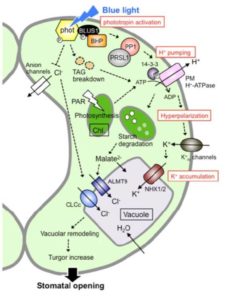Update: Blue light regulation of stomatal opening and the plasma membrane H+-ATPase
By Shin-ichiro Inoue, and Toshinori Kinoshita
 Light-induced stomatal responses were first reported 23 by Francis Darwin (1898). Stomata open in response to light, including blue and red light (Shimazaki et al., 2007). Red light induces stomatal opening via photosynthesis in the mesophyll and guard cell chloroplasts (Mott et al., 2008; Suetsugu et al., 2014). In contrast, blue light as a signal induces stomatal opening. Phototropins expressed in guard cells act as major blue light receptors for stomatal opening (Kinoshita et al., 2001; Kinoshita et al., 2003; Inoue et al., 2008). Blue light-induced stomatal opening is mediated through activation of a plasma membrane (PM) H+ pump, later identified as the PM H+-ATPase, in guard cells (Assmann et al., 1985; Shimazaki et al., 1986; Kinoshita and Shimazaki, 1999). The blue light-activated pump provides driving force for stomatal opening concomitant with ion accumulation and cell volume increase in guard cells (Schroeder et al., 1987; Kinoshita and Hayashi, 2011). Note that stomatal opening in response to weak blue light as a signal requires background red light, indicating that red light has a synergistic effect on the blue light response in guard cells (Shimazaki et al., 2007).
Light-induced stomatal responses were first reported 23 by Francis Darwin (1898). Stomata open in response to light, including blue and red light (Shimazaki et al., 2007). Red light induces stomatal opening via photosynthesis in the mesophyll and guard cell chloroplasts (Mott et al., 2008; Suetsugu et al., 2014). In contrast, blue light as a signal induces stomatal opening. Phototropins expressed in guard cells act as major blue light receptors for stomatal opening (Kinoshita et al., 2001; Kinoshita et al., 2003; Inoue et al., 2008). Blue light-induced stomatal opening is mediated through activation of a plasma membrane (PM) H+ pump, later identified as the PM H+-ATPase, in guard cells (Assmann et al., 1985; Shimazaki et al., 1986; Kinoshita and Shimazaki, 1999). The blue light-activated pump provides driving force for stomatal opening concomitant with ion accumulation and cell volume increase in guard cells (Schroeder et al., 1987; Kinoshita and Hayashi, 2011). Note that stomatal opening in response to weak blue light as a signal requires background red light, indicating that red light has a synergistic effect on the blue light response in guard cells (Shimazaki et al., 2007).
Recent investigations of guard cells with respect to blue light-induced stomatal opening have greatly advanced our understanding. In this review, we focus on the recent progress of the blue light signaling pathway in guard cells and its regulation of the PM H+-ATPase activity.




Leave a Reply
Want to join the discussion?Feel free to contribute!